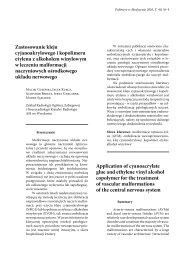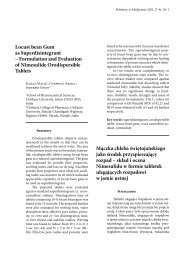peÅna wersja - pdf - Polimery w Medycynie
peÅna wersja - pdf - Polimery w Medycynie
peÅna wersja - pdf - Polimery w Medycynie
Create successful ePaper yourself
Turn your PDF publications into a flip-book with our unique Google optimized e-Paper software.
8 Jerzy Gosk i inni<br />
[3] Nichols C. M., Brenner M. J., Fox I. K., et<br />
al.: Effects of motor versus sensory nerve grafts<br />
on peripheral nerve regeneration. Exp. Neurol.<br />
(2004), 190, 347–355.<br />
[4] Ichichara S., Inada Y., Nakamura T.: Artificial<br />
nerve tubes and their application for repair<br />
of peripheral nerve injury: an update of current<br />
concepts. Int. J. Care Inj. (2008), 39S4, S29–S39.<br />
[5] Johnson E. O., Soucacos P. N.: Nerve repair:<br />
experimental and clinical evaluation of biodegradable<br />
artificial nerve guides. Int. J. Care Inj.<br />
(2008), 39S, S30–S36.<br />
[6] Jiang X., Lim S. H., Mao H. Q., et al.: Current<br />
applications and future perspectives of artificial<br />
nerve conduits. Exp. Neurol. (2009), doi:<br />
10.1016/j.expneurol.2009.09.009.<br />
[7] Bryan D. J., Holway A. H., Wang K. K., et al.:<br />
Influence of glial growth factor and Schwann<br />
cells in a bioresorbable guidance channel on peripheral<br />
nerve regeneration. Tissue Eng. (2000),<br />
6, 129–138.<br />
[8] Bini T. B., Gao S., Xu X., et al.: Peripheral nerve<br />
regeneration by microbraided poly (L-lactideco-glicolide)<br />
biodegradable polymer fibers. J.<br />
Biomed. Mater. Res. A. (2004), 68, 286–295.<br />
[9] Evans G. R., Brandt K., Widmer M. S., et al.:<br />
In vivo evaluation of poly (L-lactic acid) porous<br />
conduits for peripheral nerve regeneration. Biomaterials<br />
(1999), 20, 1109–1115.<br />
[10] Wang S., Wan A. C., Xu X., et al.: A new nerve<br />
guide conduit material composed of a biodegradable<br />
poly(phosphoester). Biomaterials (2001), 22,<br />
1157–1169.<br />
[11] Chew S.Y., Mi R., Hoke A., et al.: Aligned protein-polymer<br />
composite fibers enhance nerve regeneration:<br />
a potential tissue-engineering platform.<br />
Adv. Funct. Mater. (2007), 17, 1288–1296.<br />
[12] Hoppen H. J., Leenslag J. W., Pennings A. J.,<br />
et al.: Two-ply biodegradable nerve guide: basic<br />
aspects of design, construction and biological<br />
performance. Biomaterials (1990), 11, 286–290.<br />
[13] Robinson P. H., Van Der Lei B., Hoppen H. J.,<br />
et al.: Nerve regeneration through a two-ply biodegradable<br />
nerve guide in the rat and the influence<br />
of ACTH 4-9 nerve growth factor. Microsurgery<br />
(1991), 12, 412–419.<br />
[14] Borkenhagen M., Stoll R. C., Neuenschwander<br />
P., et al.: In vivo performance of<br />
a new biodegradable polyester urethane system<br />
used as a nerve guidance channel. Biomaterials<br />
(1999), 19, 2155–2165.<br />
[15] Waitayawinyu T., Parisi D. M., Miller B.,<br />
et al.: A comparison of polyglycolic acid versus<br />
type l collagen bioarbsorbable nerve conduits<br />
in a rat model: an alternative to autografting. J.<br />
Hand Surg. (2007), 32A, 1521–1529.<br />
[16] Dellon A. L., Mackinnon S. E.: An alternative<br />
to the classical nerve graft for the management<br />
of the short nerve gap. Plast. Reconstr. Surg.<br />
(1988), 82, 849–856.<br />
[17] Mackinnon S. E., Dellon A. L.: Clinical nerve<br />
reconstruction with a bioabsorbable polyglycolic<br />
acid tube. Plast. Reconstr. Surg. (1990), 85, 419–<br />
424.<br />
[18] Informacja o produkcie GEM Neurotube® firmy<br />
Synovis (St. Paul, MN, USA).<br />
[19] Weber R. A., Breidenbach W. C., Brown R.<br />
E., et al.: A randomized prospective study of<br />
polyglycolic acid conduits for digital nerve reconstruction<br />
in humans. Plast. Reconstr. Surg.<br />
(2000), 106, 1036–1045.<br />
[20] Ducic I., Maloney C. T. Jr, Dollon A. L.: Reconstruction<br />
of the spinal accessory nerve with<br />
autograft or neurotube Two case reports. J. Reconstr.<br />
Microsurg. (2005), 21, 29–33.<br />
[21] Navissano M., Malan F., Carnino R., et al.:<br />
Neurotube for facial nerve repair. Microsurgery<br />
(2005), 25, 268–271.<br />
[22] Hung V., Dellon A. L.: Reconstruction of<br />
a 4-cm human median nerve gap by including<br />
an autogenous nerve slice in a bioabsorbable<br />
nerve conduits: a case report. J. Hand Surg.<br />
(2008), 33A, 313–315.<br />
[23] Moore A. M., Kusukurthi R., Magil C. K., et<br />
al.: Limitations of conduits in peripheral nerve<br />
repairs. Hand (2009), 4, 180–186.<br />
[24] Inada Y., Morimoto S., Takakura Y., et al.:<br />
Regeneration of peripheral nerve gaps with<br />
a polyglycolic acid-collagen tube. Neurosurgery<br />
(2004), 55, 640–646.<br />
[25] Inada Y., Morimoto S., Moroi K., et al.: Surgical<br />
relief of causalgia with an artificial nerve<br />
guide tube: successful surgical treatment of causalgia<br />
(Complex Regional Pain Syndrome Type<br />
II) by in situ tissue engineering with a polyglycolic<br />
acid-collagen tube. Pain (2005), 117, 251–<br />
258.<br />
[26] Inada Y., Moroi K., Morimoto S., et al.: Effective<br />
surgical relief of complex regional pain<br />
syndrome (CRPS) using a PGA-collagen nerve<br />
guide tube, with successful weaning from spinal<br />
cord stimulation. Clin. J. Pain. (2007), 23, 829–<br />
830.<br />
[27] Matsumoto K., Ohnishi K., Kiyotani T., et al.:<br />
Peripheral nerve regeneration across 80-mm gap<br />
bridged by a polyglycolic acid (PGA)-collagen
















